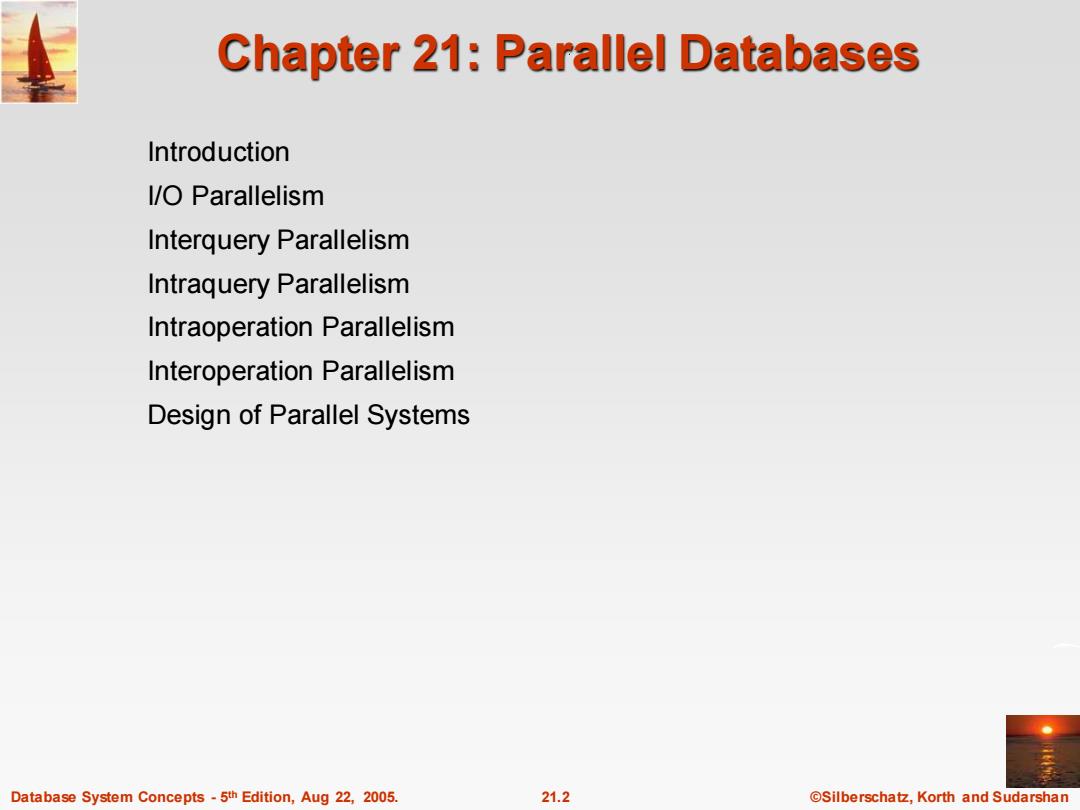
Chapter 21:Parallel Databases Introduction V/O Parallelism Interquery Parallelism Intraquery Parallelism Intraoperation Parallelism Interoperation Parallelism Design of Parallel Systems Database System Concepts-5th Edition,Aug 22,2005. 21.2 @Silberschatz,Korth and Sudarshan
Database System Concepts - 5 21.2 ©Silberschatz, Korth and Sudarshan th Edition, Aug 22, 2005. Chapter 21: Parallel Databases Introduction I/O Parallelism Interquery Parallelism Intraquery Parallelism Intraoperation Parallelism Interoperation Parallelism Design of Parallel Systems
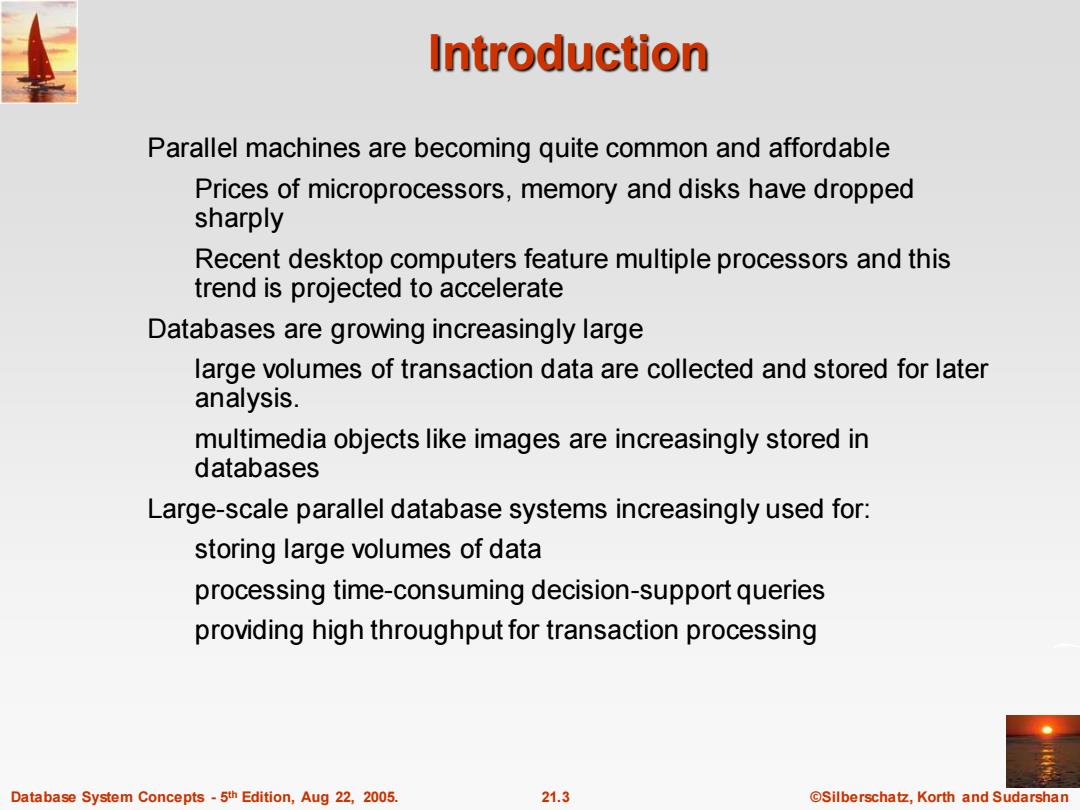
Introduction Parallel machines are becoming quite common and affordable Prices of microprocessors,memory and disks have dropped sharply Recent desktop computers feature multiple processors and this trend is projected to accelerate Databases are growing increasingly large large volumes of transaction data are collected and stored for later analysis. multimedia objects like images are increasingly stored in databases Large-scale parallel database systems increasingly used for: storing large volumes of data processing time-consuming decision-support queries providing high throughput for transaction processing Database System Concepts-5th Edition,Aug 22,2005. 21.3 ©Silberschat乜,Korth and Sudarshan
Database System Concepts - 5 21.3 ©Silberschatz, Korth and Sudarshan th Edition, Aug 22, 2005. Introduction Parallel machines are becoming quite common and affordable Prices of microprocessors, memory and disks have dropped sharply Recent desktop computers feature multiple processors and this trend is projected to accelerate Databases are growing increasingly large large volumes of transaction data are collected and stored for later analysis. multimedia objects like images are increasingly stored in databases Large-scale parallel database systems increasingly used for: storing large volumes of data processing time-consuming decision-support queries providing high throughput for transaction processing
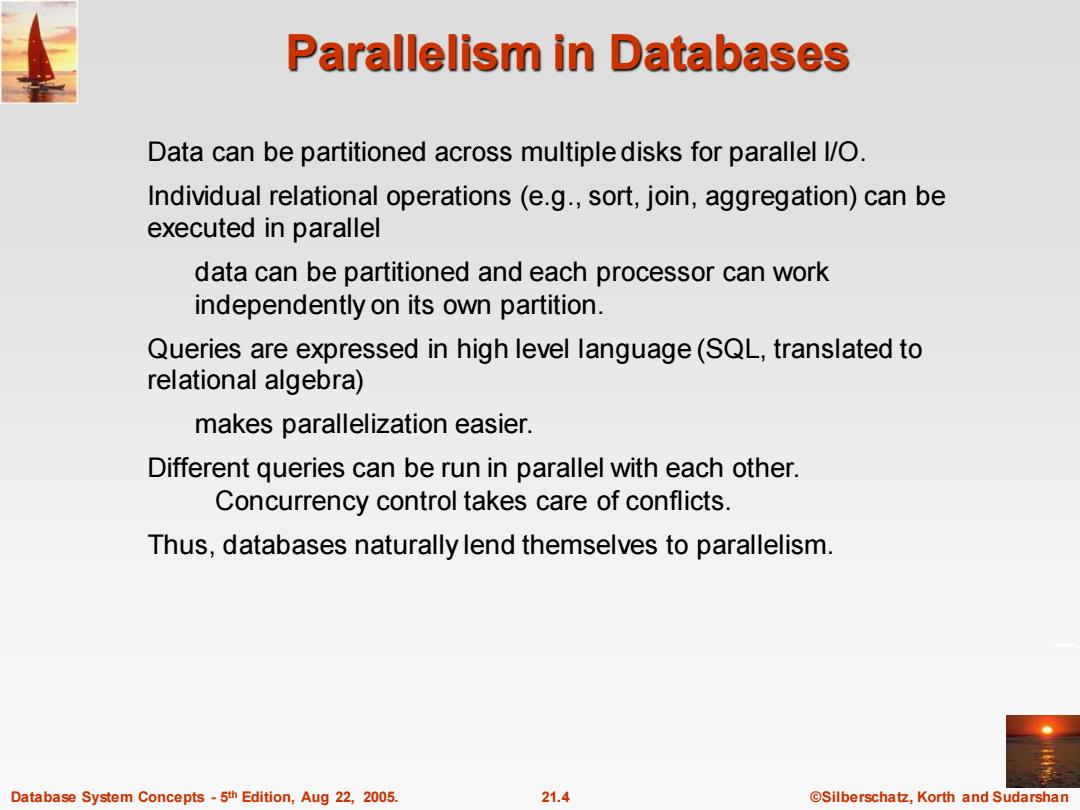
Parallelism in Databases Data can be partitioned across multiple disks for parallel l/O Individual relational operations (e.g.,sort,join,aggregation)can be executed in parallel data can be partitioned and each processor can work independently on its own partition. Queries are expressed in high level language(SQL,translated to relational algebra) makes parallelization easier. Different queries can be run in parallel with each other. Concurrency control takes care of conflicts. Thus,databases naturally lend themselves to parallelism. Database System Concepts-5th Edition,Aug 22,2005. 21.4 ©Silberschat乜,Korth and Sudarshan
Database System Concepts - 5 21.4 ©Silberschatz, Korth and Sudarshan th Edition, Aug 22, 2005. Parallelism in Databases Data can be partitioned across multiple disks for parallel I/O. Individual relational operations (e.g., sort, join, aggregation) can be executed in parallel data can be partitioned and each processor can work independently on its own partition. Queries are expressed in high level language (SQL, translated to relational algebra) makes parallelization easier. Different queries can be run in parallel with each other. Concurrency control takes care of conflicts. Thus, databases naturally lend themselves to parallelism
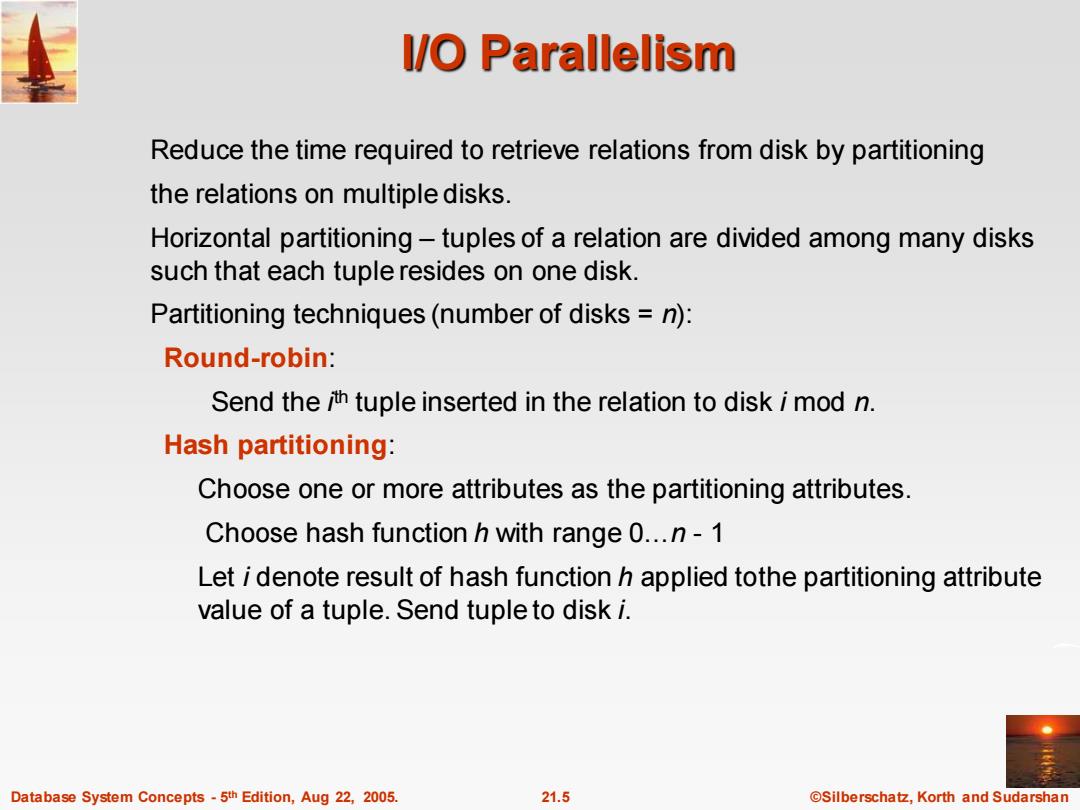
I/O Parallelism Reduce the time required to retrieve relations from disk by partitioning the relations on multiple disks. Horizontal partitioning-tuples of a relation are divided among many disks such that each tuple resides on one disk. Partitioning techniques(number of disks =n): Round-robin: Send the jth tuple inserted in the relation to disk i mod n. Hash partitioning: Choose one or more attributes as the partitioning attributes. Choose hash function h with range 0...n-1 Let i denote result of hash function h applied tothe partitioning attribute value of a tuple.Send tuple to disk i. Database System Concepts-5th Edition,Aug 22,2005. 21.5 @Silberschatz,Korth and Sudarshan
Database System Concepts - 5 21.5 ©Silberschatz, Korth and Sudarshan th Edition, Aug 22, 2005. I/O Parallelism Reduce the time required to retrieve relations from disk by partitioning the relations on multiple disks. Horizontal partitioning – tuples of a relation are divided among many disks such that each tuple resides on one disk. Partitioning techniques (number of disks = n): Round-robin: Send the i th tuple inserted in the relation to disk i mod n. Hash partitioning: Choose one or more attributes as the partitioning attributes. Choose hash function h with range 0…n - 1 Let i denote result of hash function h applied tothe partitioning attribute value of a tuple. Send tuple to disk i
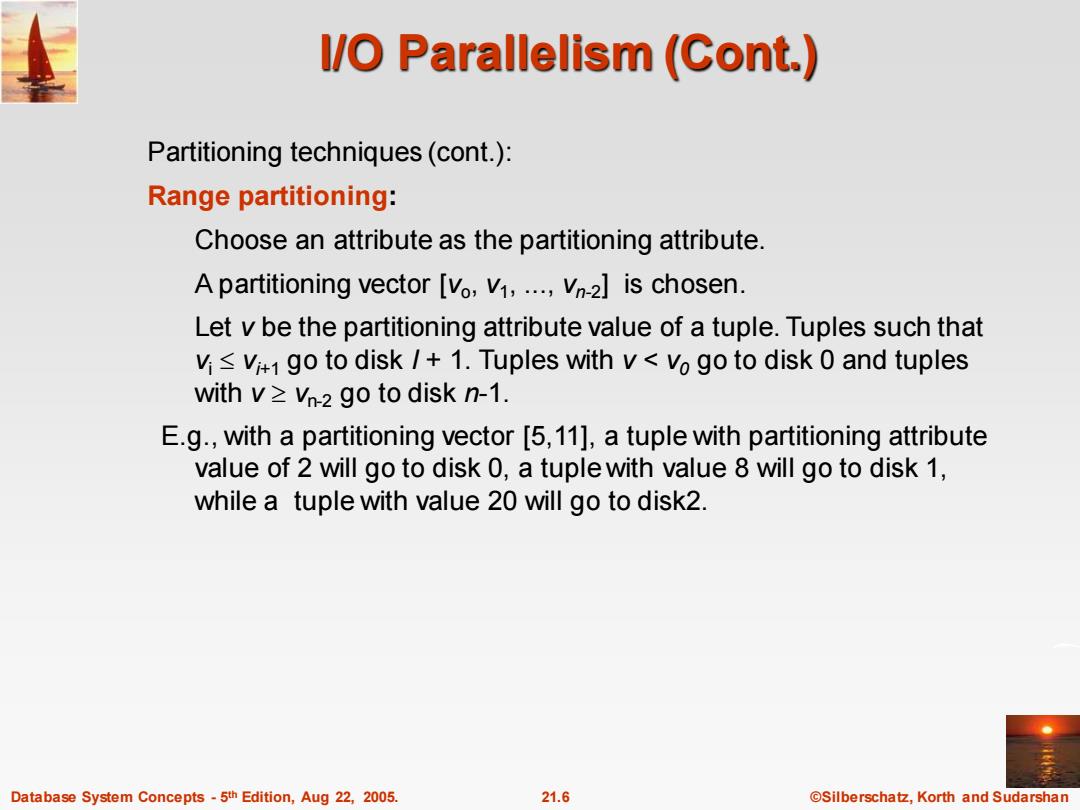
I/O Parallelism(Cont.) Partitioning techniques(cont.) Range partitioning: Choose an attribute as the partitioning attribute. A partitioning vector [vo,v1,...,v2]is chosen. Let v be the partitioning attribute value of a tuple.Tuples such that vivn-2 go to disk n-1. E.g.,with a partitioning vector [5,11],a tuple with partitioning attribute value of 2 will go to disk 0,a tuple with value 8 will go to disk 1, while a tuple with value 20 will go to disk2. Database System Concepts-5th Edition,Aug 22,2005. 21.6 @Silberschatz,Korth and Sudarshan
Database System Concepts - 5 21.6 ©Silberschatz, Korth and Sudarshan th Edition, Aug 22, 2005. I/O Parallelism (Cont.) Partitioning techniques (cont.): Range partitioning: Choose an attribute as the partitioning attribute. A partitioning vector [vo , v1 , ..., vn-2 ] is chosen. Let v be the partitioning attribute value of a tuple. Tuples such that vi vi+1 go to disk I + 1. Tuples with v < v0 go to disk 0 and tuples with v vn-2 go to disk n-1. E.g., with a partitioning vector [5,11], a tuple with partitioning attribute value of 2 will go to disk 0, a tuple with value 8 will go to disk 1, while a tuple with value 20 will go to disk2
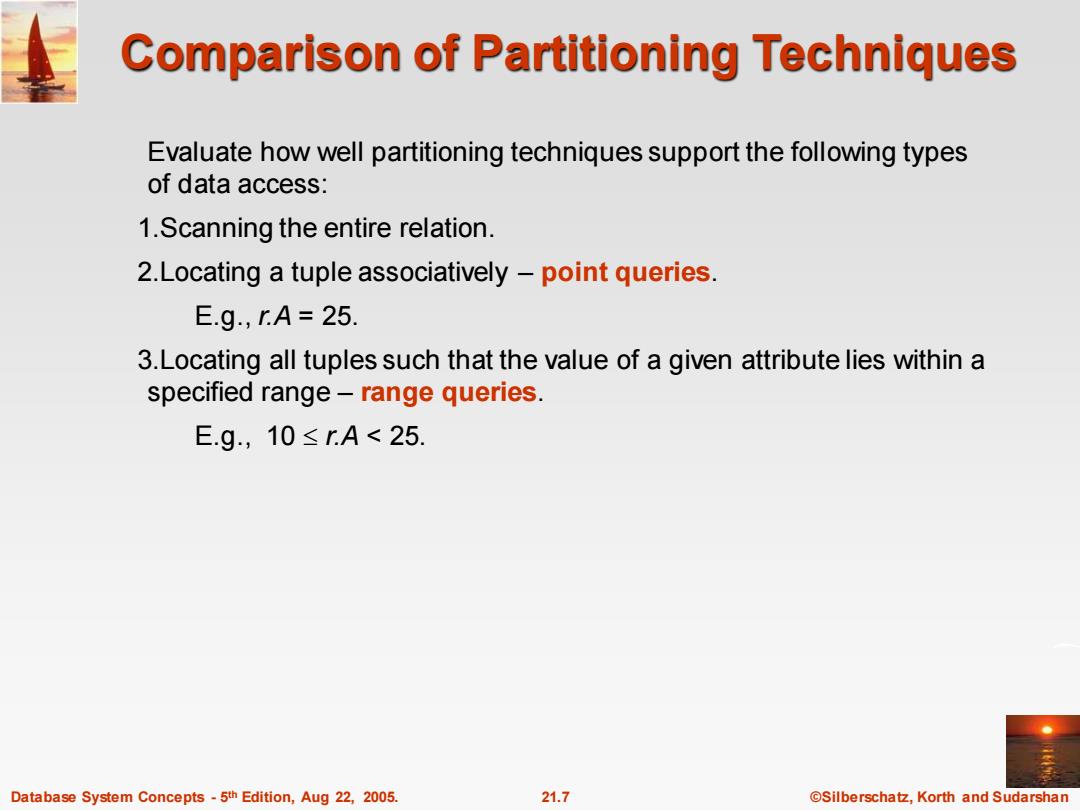
Comparison of Partitioning Techniques Evaluate how well partitioning techniques support the following types of data access: 1.Scanning the entire relation. 2.Locating a tuple associatively-point queries. E.g,KA=25. 3.Locating all tuples such that the value of a given attribute lies within a specified range-range queries. E.g.,10≤rA<25. Database System Concepts-5th Edition,Aug 22,2005. 21.7 ©Silberschat乜,Korth and Sudarshan
Database System Concepts - 5 21.7 ©Silberschatz, Korth and Sudarshan th Edition, Aug 22, 2005. Comparison of Partitioning Techniques Evaluate how well partitioning techniques support the following types of data access: 1.Scanning the entire relation. 2.Locating a tuple associatively – point queries. E.g., r.A = 25. 3.Locating all tuples such that the value of a given attribute lies within a specified range – range queries. E.g., 10 r.A < 25
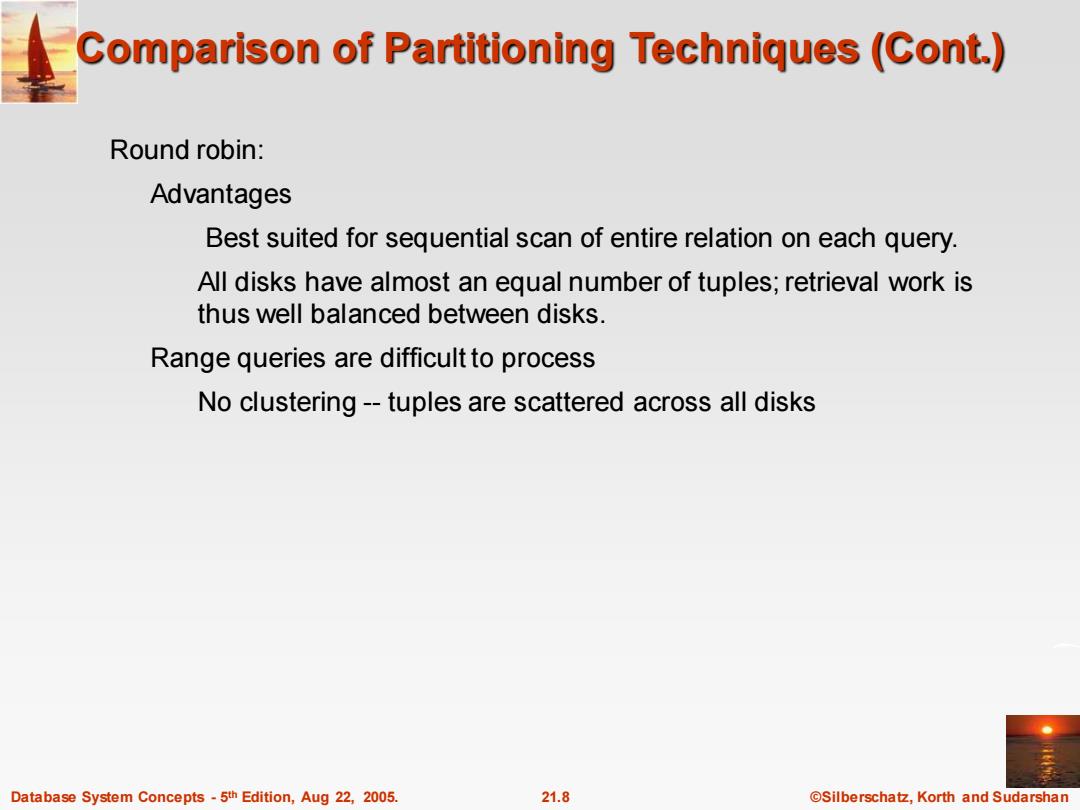
Comparison of Partitioning Techniques (Cont.) Round robin: Advantages Best suited for sequential scan of entire relation on each query. All disks have almost an equal number of tuples;retrieval work is thus well balanced between disks. Range queries are difficult to process No clustering--tuples are scattered across all disks Database System Concepts-5th Edition,Aug 22,2005. 21.8 @Silberschatz,Korth and Sudarshan
Database System Concepts - 5 21.8 ©Silberschatz, Korth and Sudarshan th Edition, Aug 22, 2005. Comparison of Partitioning Techniques (Cont.) Round robin: Advantages Best suited for sequential scan of entire relation on each query. All disks have almost an equal number of tuples; retrieval work is thus well balanced between disks. Range queries are difficult to process No clustering -- tuples are scattered across all disks
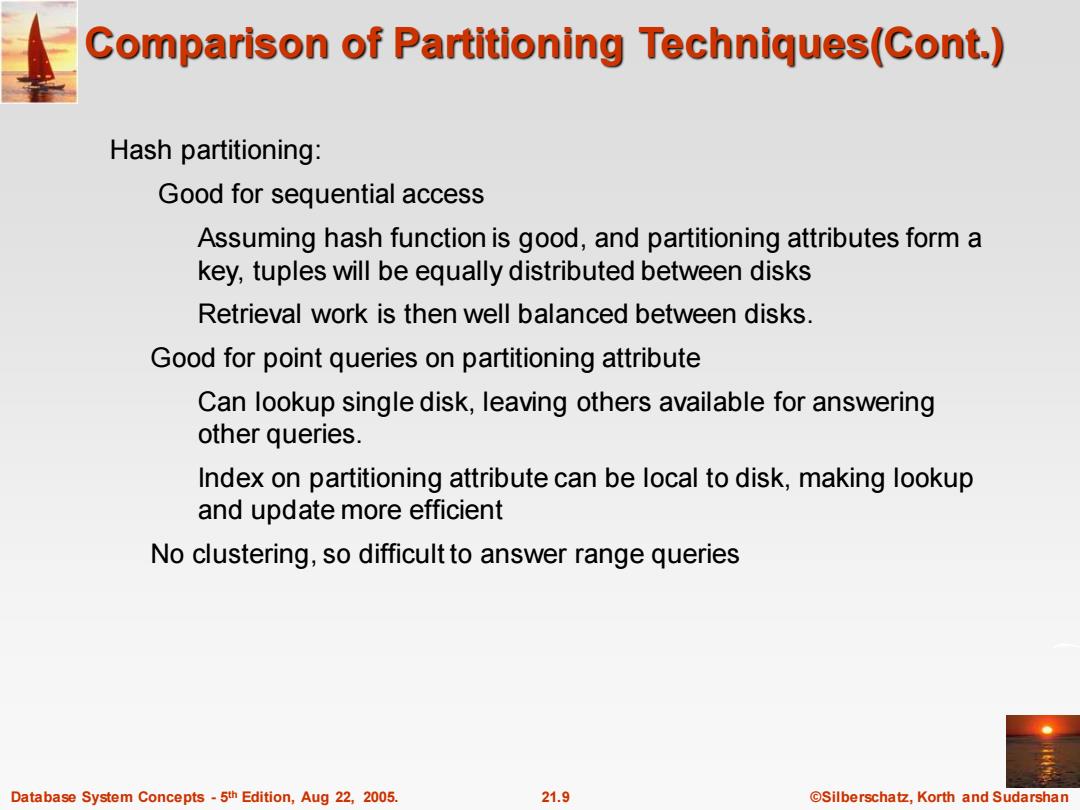
Comparison of Partitioning Techniques(Cont.) Hash partitioning: Good for sequential access Assuming hash function is good,and partitioning attributes form a key,tuples will be equally distributed between disks Retrieval work is then well balanced between disks. Good for point queries on partitioning attribute Can lookup single disk,leaving others available for answering other queries. Index on partitioning attribute can be local to disk,making lookup and update more efficient No clustering,so difficult to answer range queries Database System Concepts-5th Edition,Aug 22,2005. 21.9 ©Silberschat乜,Korth and Sudarshan
Database System Concepts - 5 21.9 ©Silberschatz, Korth and Sudarshan th Edition, Aug 22, 2005. Comparison of Partitioning Techniques(Cont.) Hash partitioning: Good for sequential access Assuming hash function is good, and partitioning attributes form a key, tuples will be equally distributed between disks Retrieval work is then well balanced between disks. Good for point queries on partitioning attribute Can lookup single disk, leaving others available for answering other queries. Index on partitioning attribute can be local to disk, making lookup and update more efficient No clustering, so difficult to answer range queries
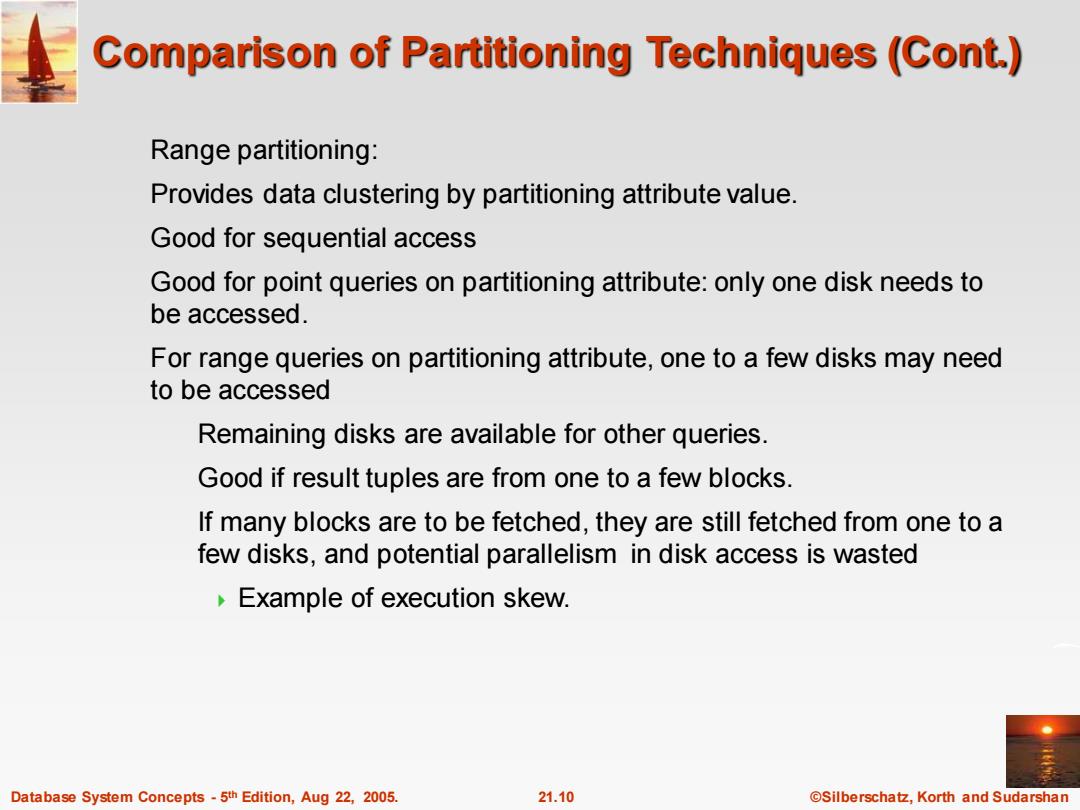
Comparison of Partitioning Techniques(Cont.) Range partitioning: Provides data clustering by partitioning attribute value. Good for sequential access Good for point queries on partitioning attribute:only one disk needs to be accessed. For range queries on partitioning attribute,one to a few disks may need to be accessed Remaining disks are available for other queries. Good if result tuples are from one to a few blocks. If many blocks are to be fetched,they are still fetched from one to a few disks,and potential parallelism in disk access is wasted Example of execution skew. Database System Concepts-5th Edition,Aug 22,2005. 21.10 ©Silberschat乜,Korth and Sudarshan
Database System Concepts - 5 21.10 ©Silberschatz, Korth and Sudarshan th Edition, Aug 22, 2005. Comparison of Partitioning Techniques (Cont.) Range partitioning: Provides data clustering by partitioning attribute value. Good for sequential access Good for point queries on partitioning attribute: only one disk needs to be accessed. For range queries on partitioning attribute, one to a few disks may need to be accessed Remaining disks are available for other queries. Good if result tuples are from one to a few blocks. If many blocks are to be fetched, they are still fetched from one to a few disks, and potential parallelism in disk access is wasted Example of execution skew
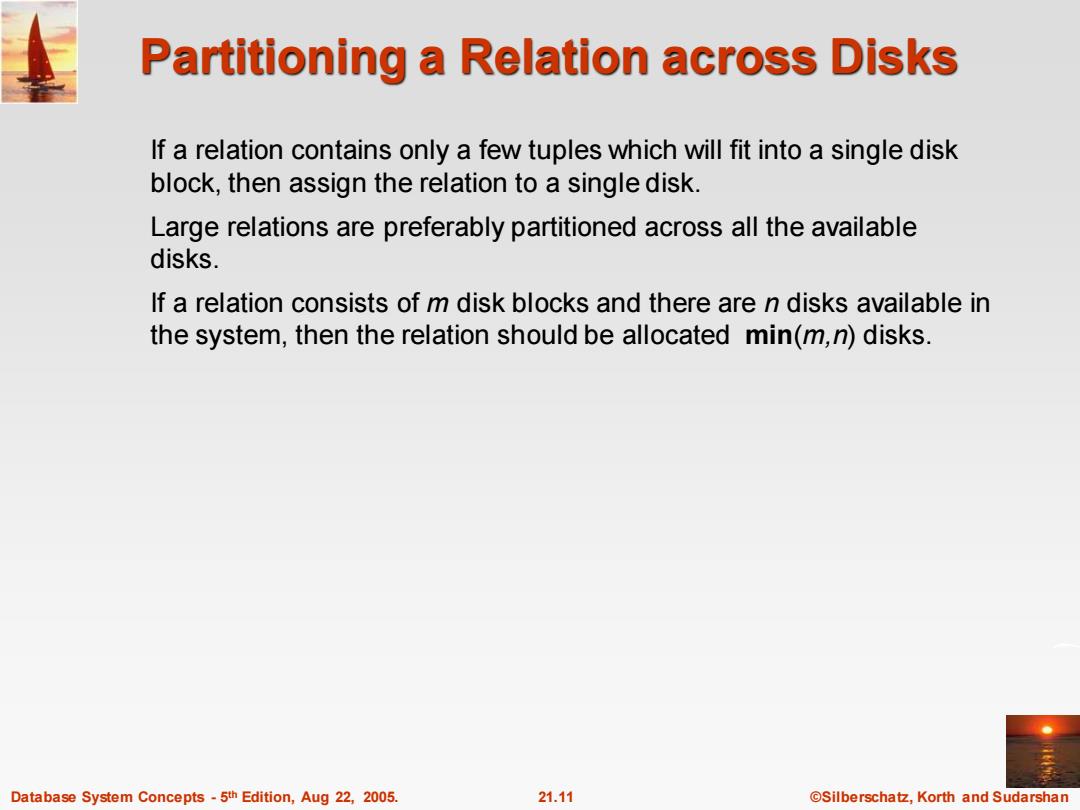
Partitioning a Relation across Disks If a relation contains only a few tuples which will fit into a single disk block,then assign the relation to a single disk. Large relations are preferably partitioned across all the available disks. If a relation consists of m disk blocks and there are n disks available in the system,then the relation should be allocated min(m,n)disks. Database System Concepts-5th Edition,Aug 22,2005. 21.11 ©Silberschat乜,Korth and Sudarshan
Database System Concepts - 5 21.11 ©Silberschatz, Korth and Sudarshan th Edition, Aug 22, 2005. Partitioning a Relation across Disks If a relation contains only a few tuples which will fit into a single disk block, then assign the relation to a single disk. Large relations are preferably partitioned across all the available disks. If a relation consists of m disk blocks and there are n disks available in the system, then the relation should be allocated min(m,n) disks